1. Introduction
In view of the current severe energy situation, it is urgent to develop new energy to reduce the proportion of fossil energy in the energy structure. As one of the most promising clean energy sources, solar energy has not been widely used due to low power generation efficiency and high equipment costs. Therefore, it is possible to start from the perspective of concentrating and tracking solar energy to improve the output power of solar cells per unit area and overcome solar energy dispersion, which is also the purpose of this topic.
At present, the main ways of solar power generation include tower power generation, dish power generation, photovoltaic power generation, etc., but there are problems of low utilization rate of solar energy. How to improve the utilization rate of solar energy has been a hot topic in recent years for scholars at home and abroad. To solve this problem, we can start from two aspects, one is to improve the energy conversion rate of solar devices, and the other is to increase the reception rate of solar energy. In this article, both are covered, but focus on the second aspect.Studies have shown that concentrating solar tracking systems can effectively improve the utilization rate of solar energy, and the research show that the energy reception rate of tracked and untracked solar energy differs by 37.7%. Therefore, the concentrating solar tracking system can provide an effective solution to solve the problem of low solar energy utilization. With accurate sun tracking technology, we can use solar energy more efficiently and bring more opportunities for solar energy development.
2. Germanium cells and silicon cells
Table 1. Comparison of germanium cells and silicon cells.
Typical Performance Index | Si Solar Cell | GaAs Solar Cell | ||||||
Unijunction | Double-junction | Three-junction | Four-junction | |||||
Photoelectric Conversion Efficiency/% | 12 | 14 | 19 | 22 | 26 | 30 | 35 | |
Area Specific Power/(W \( ∙{m^{2}} \) ) | 130 | 150 | 205 | 235 | 280 | 320 | 375 | |
Mass Specific Power/(W \( ∙{kg^{-1}} \) ) | 55 | 65 | 80 | 90 | 110 | 125 | 145 | |
Operating Life | Low Orbit | 2-3 | 5-7 | 7-10 | 7-10 | 10-15 | 10-15 | |
High Orbit | 10-15 | 15-20 | 20-25 | 20-25 | 25-30 | 25-30 | ||
Solar Array Cost Factor | 1.0 | 2.0 | 1.6 | 1.2 | 0.8 | 0.5 | ||
The above table [1] is about the comparison of parameters of silicon solar cells and gallium arsenide solar cells with germanium as the substrate in terms of photoelectric conversion efficiency and area specific power. It can be seen that the photoelectric conversion efficiency of germanium cells is 7% to 23% higher than that of silicon cells, and the area specific power can reach more than twice that of silicon cells.
From the above table, it can be concluded that gallium arsenide solar cells have higher photoelectric conversion rate, larger area ratio and mass ratio power, and longer working life than silicon solar cells. In addition to high voltage and good temperature resistance, the unique advantages of gallium arsenide solar cells make it the first choice for future space photovoltaic technology. However, due to its high price, its commercial application is still relatively backward. Considering the high cost of GaAs/Ge solar cells, in order to maximize the photoelectric conversion efficiency, it is usually necessary to add a concentrating mechanism and a tracking mechanism to operate together.
3. Classification and selection of concentrators
According to the way light is concentrated, concentrators can be divided into refractive concentrators and reflective concentrators. Refractive condensers are mainly based on Fresnel lenses and ordinary lenses. Reflective concentrators include trough concentrators, tower concentrators, dish concentrators, and multispecular concentrators [2].
Fresnel lens, also known as ring band lens, corrugated lens or threaded lens, is a new optical component invented by the famous French physicist Fresnel with the characteristics of flatness, usually composed of a series of concentric prismatic grooves, which can provide clear visual effects. They are widely used in focusing and imaging fields. Fresnel lenses also have defects, uneven light concentration and difficulty in manufacturing large parabolic surfaces limit the popularity of Fresnel lenses in solar concentrating systems to a certain extent.
Trough solar concentrating technology was realized earlier than other concentrating methods. The principle of trough solar concentrator is: the use of trough parabolic mirror, the sunlight concentrated on the receiver, this plane is formed by the parabola through precise translation, when the sunlight shines, it will be concentrated to the focus of the original parabola according to the geometric principle. [3] The trough concentrator is shown in Figure 1.
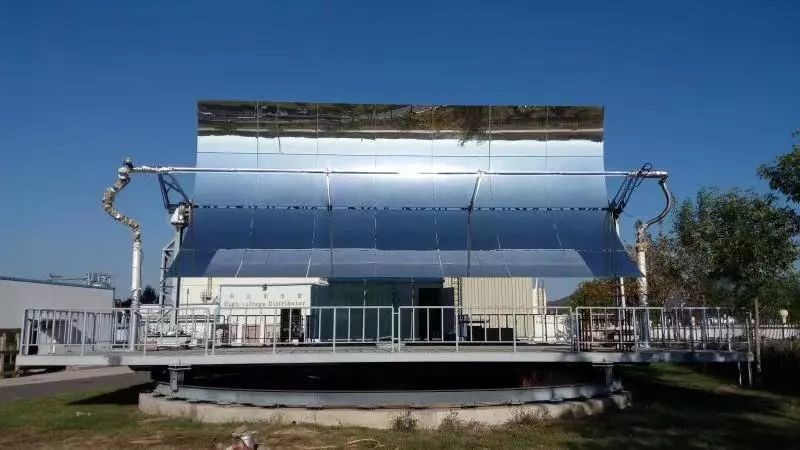
Figure 1. Trough solar concentrator.
Although the trough solar concentrating system has low utilization efficiency, it has a simple structure and low cost, and is a relatively mature solar power generation technology so far.
Tower solar concentrating systems can focus the sun's rays onto a fixed collector and heat the working fluid to produce high-temperature steam or gases that can be converted into electricity by driving generator sets. The system consists of a heliostat, an endothermic and heat transfer system, and a generator. [4] They all have the function of automatically tracking the sun, so the orientation of the heliostat can be adjusted according to the position of the receiver, so that a higher light gathering effect can be achieved.
The tower concentrating system is relatively large in scale and is not suitable for promotion and use in household small solar energy systems. The figure 2 is the tower concentrator.
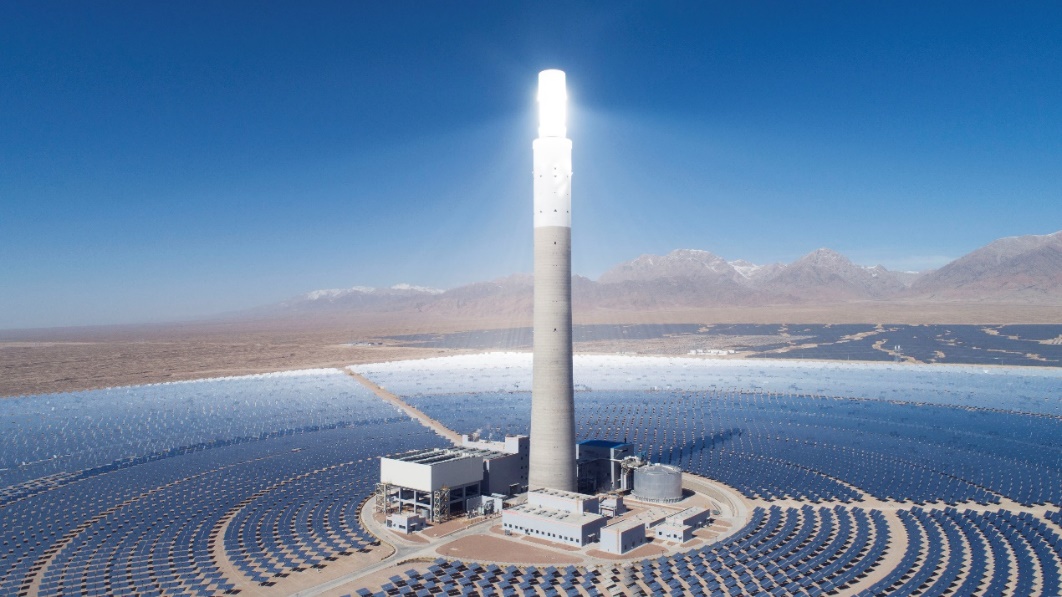
Figure 2. Tower concentrator.
A dish concentrator is an important solar concentrating device, which consists of two independent mirrors. One is a rotating parabolic mirror, which is usually larger in size to better concentrate light. The other is multiple mirrors, which are the same size but are usually made up of a combination of many small surfaces due to cost. The structure of the multi-disc mirror can not only significantly improve the concentration ratio, but also greatly improve the performance of the entire concentrating system. A multi-dish mirror consists of several small rotating parabolic mirrors with exactly the same focus.
The disc concentrator has a high concentrating multiple, small start-up loss, and a much higher power generation efficiency than several other solar concentrating systems. However, the dish concentrator also has certain shortcomings, because the dish solar concentrator is arranged in a continuous curved surface, its surface accuracy requirements are high, and the processing cost is relatively high. The dish concentrator is shown in Figure 3.
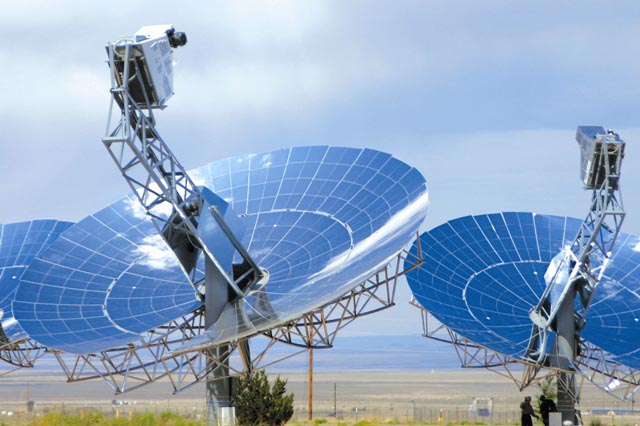
Figure 3. Dish concentrator.
Since the purpose of this system is to improve the efficiency of solar power generation and solar energy utilization, the most efficient dish concentrator is finally selected as the concentrating mechanism of the system after considering various factors.
4. Choice of tracking method
4.1. Visual-solar motion trajectory tracking
Apparent solar trajectory tracking can determine the specific position of the sun. This process requires the use of GPS, which is able to provide highly accurate geographic latitude and local time information. In this way, we can track the position of the sun in real time based on this information, so as to achieve the high precision and reliability we need [5].
Through the ground coordinate formula, the control system can calculate the azimuth and altitude angle of the sun. When these values reach a specific value, it is transmitted to the tracking device through the motor, which rotates it in two dimensions to achieve an accurate measurement of the ground. When the sun sets, the tracking device stops running and returns to its starting position along a predetermined trajectory.
However, this tracking method is extremely complex, and the increase in the amount of calculation will also lead to an increase in the cost of control. In addition, since the system is an open-loop system and there are no angular feedback values to compare, extremely fine machining and instrument installation are necessary to achieve the tracking accuracy requirements. When initializing the installation, the center of the instrument should coincide exactly with the geographic location of the observation point. In addition, to ensure the accuracy of the instrument, the bottom of the instrument needs to be adjusted by a horizontal collimator to ensure that its altitude angle zero point is within ground level [6].
4.2. Photoelectric tracking
In photoelectric tracking, by using photosensitive elements, the position of the sun can be accurately monitored and the target tracking can be achieved by driving signals. The position detection unit uses a high-precision photosensitive element, which can monitor the position change of the sun in real time and transmit the corresponding electrical signal to the microprocessor; the control unit is responsible for processing these transmitted electrical signals and converting them into operational control signals; finally, the execution unit is responsible for tracking the sun, and after receiving the instructions of the drive unit, it will automatically complete the tracking task [7].
By using photoelectric tracking technology, we can monitor the position of the sun in real time and react. This is a closed-loop system with high tracking accuracy, high sensitivity, and low cost. However, photoelectric tracking technology also has some drawbacks, for example, sunlight is blocked for various reasons, resulting in the detection unit being unable to accurately capture the position of the sun. When a strong light (such as light or specular reflection) is detected on an object, the detection unit has difficulty distinguishing the sun from the spot, causing them to be confused, causing the actuator to operate incorrectly, resulting in deviation from the tracking results. Therefore, the photoelectric tracking system is only suitable for tracking in sunny weather and no other main light sources, once the weather changes greatly or there is interference from external light sources, the stability of the entire tracking system will be greatly reduced.
4.3. Hybrid tracking
From the discussion above, it can be seen that the apparent solar motion trajectory tracking technology controlled by open loop control can calculate the relative position of the sun at any time and any place according to astronomical algorithms, and track it in real time through the program-driven actuator. Although this method can resist the influence of weather changes, due to the existence of accumulated errors and the inability to correct, the tracking accuracy cannot be effectively guaranteed. The closed-loop control system using photoelectric tracking technology uses photosensitive elements to detect sunlight, which has high sensitivity and tracking accuracy, but due to the influence of the external environment, the stability of the system cannot be guaranteed.
Therefore, this paper combines the strengths of the two, adopts a hybrid tracking device, and adopts a dual-axis installation method, with apparent day motion trajectory tracking as the main tracking link and photoelectric tracking as the feedback link to correct the tracking error. When it is cloudy, photoelectric tracking stops working, apparent day motion trajectory tracking completes tracking alone, once the sun appears, photoelectric tracking immediately plays a role, continue to correct tracking errors
5. System modeling and simulation
This paper uses Matlab to model and simulate the system. Firstly, according to the analysis of the corresponding output characteristics of germanium wafer solar photovoltaic conversion efficiency, the maximum power point tracking controller is designed. Then, the concentrating mechanism and the sunward tracking controller are integrated for system simulation.
In the simulation process, the stationary solar power generation system is used as a comparison to verify the effectiveness and economy of the concentrating germanium solar power generation system. The results show that the energy harvesting efficiency of the concentrated germanium solar power generation system is about 30% higher than that of the stationary solar power generation system, and it also has advantages in terms of economy. Figures 4 and 5 are block diagrams and structural diagrams of the system, respectively. These include solar panels, given voltage signals, output voltages, output power, and more.
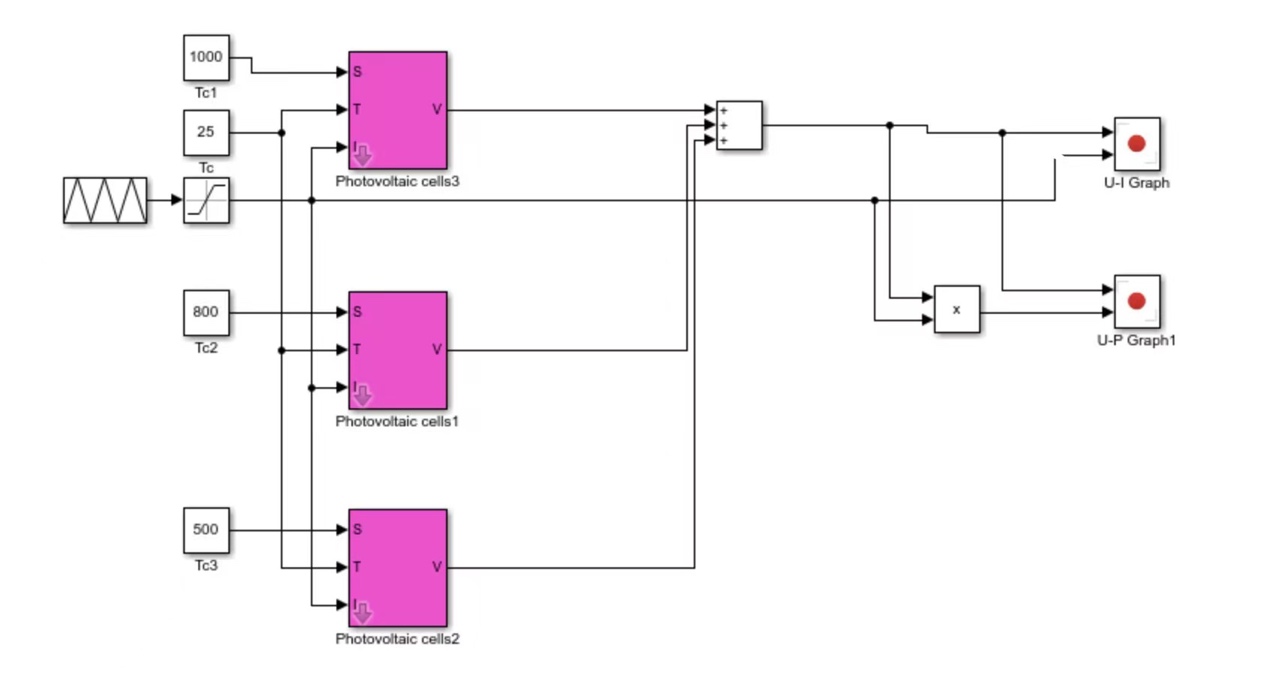
Figure 4. System block diagram.
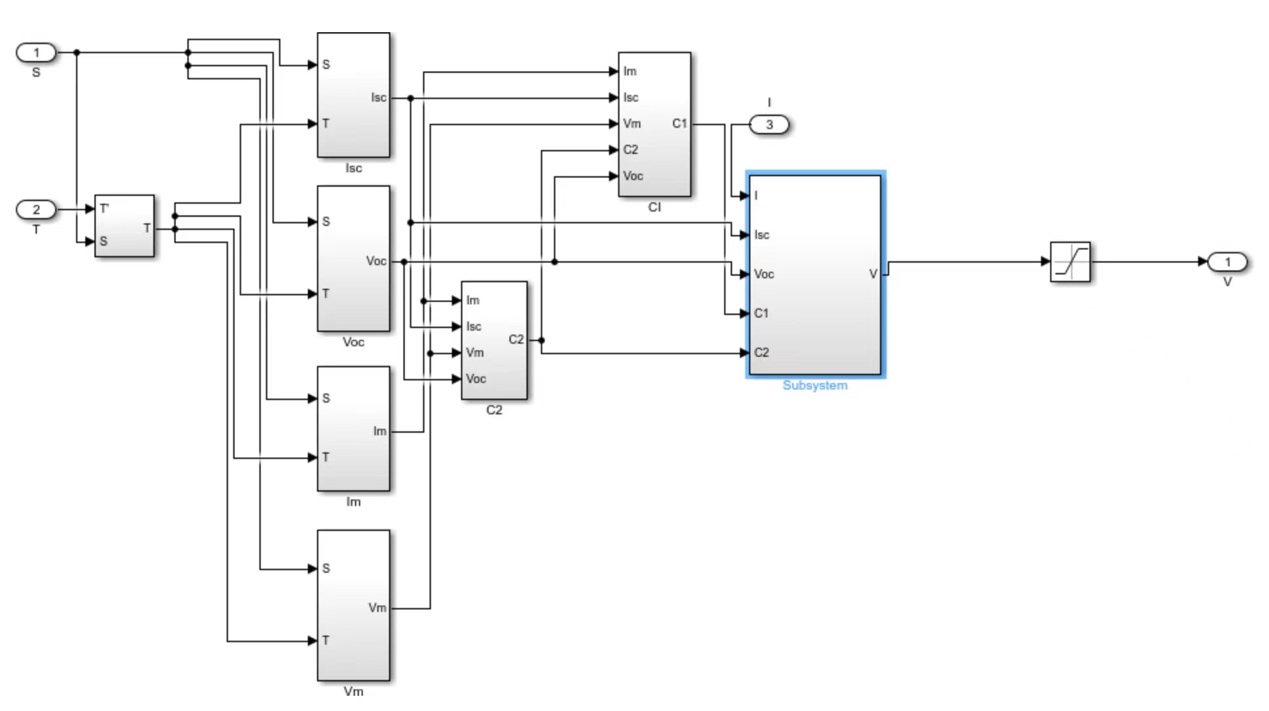
Figure 5. Structure diagram.
The simulation results are shown in Figure 6. It can be seen from the figure that the concentrated germanium solar power generation system studied in this paper can indeed improve the efficiency of solar power generation.
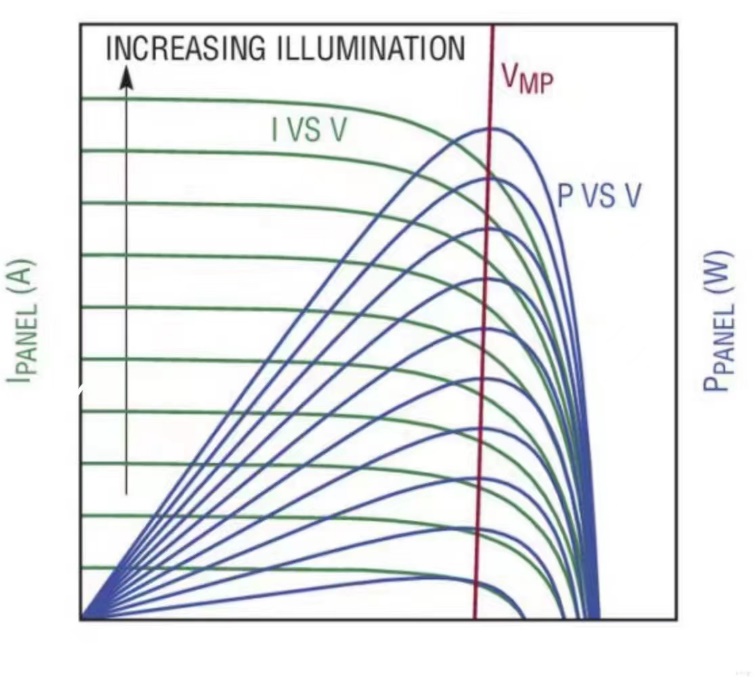
Figure 6. Simulation result plot.
6. Conclusion
This paper first discusses the overview of germanium solar cells, and analyzes the advantages of germanium cells in photoelectric conversion efficiency and working life compared with silicon solar cells. Next, four concentrating systems are listed, their advantages and disadvantages are compared, and finally the disc concentrator is selected as the concentrator device. Then, three ways of tracking the sun are discussed, compared from the aspects of tracking accuracy and cost, and finally decided to combine the advantages of apparent sun trajectory tracking and photoelectric tracking, and adopt hybrid tracking methods to achieve the purpose of high-precision and high-stability tracking. Finally, the whole system is run through Simulink simulation, and compared with the traditional fixed solar power generation system, it is further demonstrated that the concentrated germanium solar power generation system designed in this paper has obvious advantages in improving solar energy utilization and photoelectric conversion efficiency.
Acknowledgements
This thesis was completed under the careful guidance of Mr. Wei Bei and the patient help of the members of the group, and I would like to express my sincere gratitude to all the teachers, classmates and family members around me who have helped and supported me!
First of all, I would like to thank my dear teacher Wei Bei, whether it is his acceptance and encouragement when I was choosing my mentor in my junior year, or the help and guidance he gave me during the writing of my senior thesis, which made me feel warm and I will remember it in my heart. In less than a year of getting along, I have great admiration and gratitude for Mr. Wei's profound knowledge, rigorous academic methods and patient guidance. Whether it is the selection of the topic of this article, the context of the article, and even the key details in each chapter, a lot of effort has been poured into Mr. Wei. The teacher will always find the problems in my articles in time and give constructive suggestions, which gives my confused thoughts direction. Here, I would like to express my highest respect and heartfelt thanks to Teacher Wei for her sincere guidance and sincere care in study and life!
In addition, I am very grateful to the family and friends who have been silently accompanying me and supporting me, because with you, I will be very excited even if I encounter setbacks, and you have always been by my side to escort me and let me spend four years of college life safely and happily.
Finally, I would like to express my heartfelt thanks to all the teachers, classmates and family members who have helped me!



